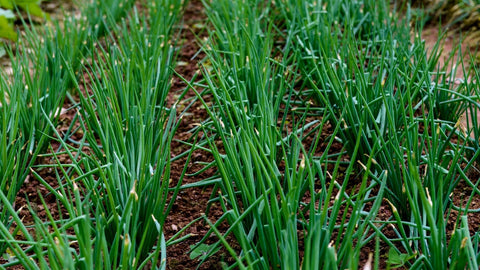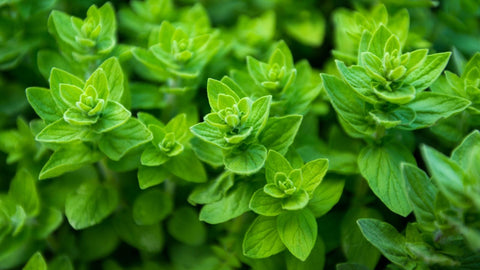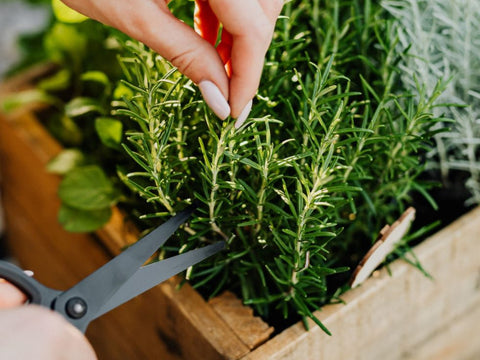Chives were some of the ancient Romans' favorite herbs - so much so that clumps still grow in the English countryside wherever their soldiers camped. In this blog, we’ll be talking about everything related to growing chives outdoors, from basic facts, supplies, setup, and steps to grow, care for and harvest it, and gardening zones in the US and how they can impact outdoor gardening.
|
Plant type |
Perennial |
|
Family |
Alliaceae |
|
Binomial name |
Allium schoenoprasum |

Timing
Chives sprout in 1-2 weeks. Then they can be harvested from Month 3+ on.

Part sun
Chives need at least an equivalent of 5+ hours of direct sun [DLI of 15+ mol/m²/day].

Care
Growing chives outdoors is beginner-friendly, but it can involve a few more steps compared to growing it indoors. You’ll thin, prune, harvest and maybe try to get rid of pests and other problems from time to time.
Ways to Grow Chives Outdoors
Growing Chives Outdoors Using Soil
Chives plants don’t do well in moist soil conditions. The roots are not accustomed to being too wet and will rot in boggy conditions. On the other hand, if the soil dries out completely the roots will die back and the plant won’t recover. This can catch you off guard because the plant’s not very expressive (its leaves don’t wilt) so it will look fine right up until it dies.
You have two options to choose from when growing chives outdoors:
- Plant directly onto soil, or
- Use a container - with drainage!
If you prefer planting directly onto soil, you can use potting mixes you can buy from stores or online, or you can also create your own. In this blog, we explained how to create your own potting mix. Just remember that herbs such as chives thrive more in nutrient-dense soils, so if you don’t have that, you can also look into incorporating plant foods or fertilizers.
We prefer using containers as we have more control over the growth of herbs by using this method. Some herbs can grow aggressively and take over the whole space of garden beds or soil sites. Take note that if you opt for containers, they should have good drainage as herbs such as chives thrive well in this kind of environment. If you’re not sure what size of pot or container to use for your herbs, check this out.
You can also see the table comparison below about the pros and cons of soil and containers:
|
Pros |
Cons |
|
|
Soil (in ground) |
|
|
|
Container |
|
|
Other Ways to Grow Chives Outdoors
You can also use ollas (plant watering spikes/globes) for your containers to help with drainage. Raised beds are a good choice for growing herbs such as chives outdoors, too.
Best Gardening Zones for Growing Chives Outdoors
Chives can be grown in most areas as they are sun-loving herbs that can adapt to a range of temperatures, but the most recommended zones are zones 3-9.
You can also check out how to grow chives indoors if you’d like your chives plants to be transplanted or grown indoors instead.
Care and Maintenance of Chives Outdoors
Lighting for Growing Chives Outdoors
Chives plants are sun-loving herbs, meaning they need lots of light – but since you’ll be growing them outdoors, you just need to make sure that they would be put in a very bright place that gets at least 5+ hours of direct sunshine.
The Right Temperature for Your Chives Outdoors
Extend Your Harvest by Keeping the Temperatures Cool
The chives plant is known as a “cool weather crop.” Therefore you can grow chives outdoors even during the winter. If it senses warming temperatures, it will “bolt” - send up flowers and become bitter in the process.
Water and Humidity
Herbs such as chives thrive on an adequate amount of moisture but can suffer if they’re waterlogged, so make sure to water them just enough, especially if you’re using soil. To avoid your chives being waterlogged, make sure to use a pot with drainage, or just use self-watering pots, as mentioned above.
Nutrients and Fertilizers
Chives like to start with nutrients that are equal parts nitrogen, phosphorus, and potassium (with NPK numbers like 10-10-10). For this Balanced Blend, we recommend: Dr. Earth All Purpose
Once they are growing, it’s better to use plant food that is high in nitrogen (with NPK numbers like 10-5-5). For this Herb Blend, we recommend: Joyful Dirt All Purpose
Moving Your Outdoor Chives Indoors
Chives mostly thrive in colder temperatures, as we mentioned above. So we suggest moving your chives indoors only when the temperature gets to be a little bit too warm for its liking. To learn more about how to grow your chives indoors, check this out.
Common Problems With Growing Chives Outdoors
Pests
As you’ll be growing your chives outdoors, you need to keep in mind that you might encounter pests such as onion maggots and thrips. To learn more about managing these pest problems for chives, you might want to check this article from PlantVillage out.
Diseases
Growing plants outdoors or indoors can bring risks to your plants such as mildew and blight. There are different solutions for each of these diseases and for you to know more about them, we suggest reading through this helpful article from PlantVillage.
Timeline and Steps on How to Grow Chives Outdoors
Best Setup for Chives Outdoors
Below is the best setup (and a very easy one!) for growing your chive plants outdoors. You’ll need:
Planter:
Ceramic Self Watering Planter (preferred) or pot that is at least 4″ / 1 pint. Raised beds and ollas are also great choices.
Soil:
Free-Draining Mix
Plant Food:
At the start: Balanced Blend. This should be equal parts nitrogen, phosphorus, and potassium (with NPK numbers like 10-10-10).
Ongoing: Herb Blend. This should be high in nitrogen (with NPK numbers like 10-5-5).
Starting your Chives: Seed vs Propagate vs Nursery Plant
Chives are easy to start from seed. If you are feeling impatient – they’re also easy to propagate by dividing an established clump or buying a pot of them (you can even find them at grocery stores).
How to Plant Chives Seeds
Chives grow quickly from seed. Plant 10 sites in a 4″ / 1-pint container. In larger containers, space sites 1/2″ apart. For each site, plant 5 seeds 1/4 inches deep. Keep the soil warm ( 45-95°F, ideally 60°F). Sprouts typically appear in 14 days but can be as quick as 7 days or as long as 21 days depending on your conditions.
Propagating Established Bunches: How to Divide Chives
Chives replicate underground – so if you’ve already got an established plant you love (or a friend does!) you can easily “clone” it by dividing the bunch. First, give it a good watering to loosen up the roots. Then pull the entire cluster out and gently tease the roots apart. That’s it!
How to Transplant Chives
Live starter plants give you a big jump start on your first harvest. When you’re in a garden center – pick the bushiest plant available (tall and lanky ones will be weak growers) and give it a good inspection for pests. Leaves should be dark green without holes, spots, or curled edges. A best practice is to actually “quarantine” your plant for about a week after bringing it home to make sure it’s free and clear of ride-on pests.
Ensuring it’s pest and disease-free it’s time to transplant your seedling into its final home.
- Remove some soil from its final planter – leaving enough space for the bottom of the seedling to be just higher than the soil surface.
- Hold on to the base of the stem with one hand, and turn the pot over while gently pulling the seedling. Giving the pot a few squeezes can help dislodge it.
- Place in its final container and fill around it with soil so that it’s tight, but not compacted.
Week 1-2: Check for Sprouts
You could see seedlings in as little as 7 days (though 14 days is more typical). If it’s been 21 days and you still don’t have any sprouts, it’s likely that your setup is too cold.
Week 5: Check Your Seedlings
There’s no need to thin Chives, but you should check on your seedlings’ progress to make sure you’ve got enough light. They should be about 1 inch tall by the end of Week 5. If they aren’t you likely need a bit more light.
Month 3: How to Prune & Harvest Chives Plants
You’ll notice how all the stems and leaves of Chives grow from a single, central point (called radial growth). The plant puts out new leaves in the center and pushes old leaves outward, getting bigger and bushier over time.
Pruning and harvesting are one-in-the-same with Chives. Once the plant has at least 3 separate stems coming from the base, take one of the outside leaves and cut it close to the base (½” above is fine). It’s good to leave at least 2/3rds of the plant left to regrow. If you only want a tiny amount of herbs, you also can clip the top of an individual stem – just be sure to leave some leaves on that stem, otherwise it won’t grow back.
Month 3+: How to Harvest Chives
Cut the stem clear to the base – only cutting what you can use fresh. Each time you cut, new stems will come in to replace them – kind of like mowing the lawn.
How to Use Your Freshly-Harvested Chives in Cooking
Most herbs are a staple used in the kitchen by the most prominent chefs around the world to ordinary food lovers at home. One of them is chives - which can be used in many ways:
- Garnish for soups
- Added to salads
- Added to eggs or any other dish you could think of
Check out some more of our favorite chives recipes here.
How to Preserve Chives
There are several ways to preserve or keep your herbs fresh, and here are just some of the easiest and the ones we recommend the most:
- Lazy person technique: Keep the fresh herbs in their original packaging and store them in the fridge.
- Storing the herbs in a glass of water inside the fridge: Cut the end of the stem of your herb, fill a glass jar or cup with water, and place your herb inside.
- Keep in a glass of water under natural lighting.
- Wrap loosely in a damp paper towel.
- Freeze them: Yes, you can freeze fresh herbs such as chives to use later. All you need are some ice cube trays and a freezer, and you’re all set.
Learn more about how to preserve and keep your herbs and chives fresh here.
Year 2: End of Life
Chives grow from an underground bulb that multiplies every year, so a clump can produce indefinitely. In its second year, the first bulbs will flower – they’re edible and should be harvested right after they open.
If you’d like to learn about the dozens of other herbs, fruits, and vegetables that you can grow indoors or outdoors, then grab a copy of our free eBook below.
Best Varieties for Growing Chives Outdoors
Growing chives indoor or outdoors is very much possible since they are the smallest edible plant. Green onions/scallions are a bit bigger - are all part of the same family if you want a more dramatic look. Here are the top 4 varieties we recommend for growing chives outdoors:
Evergreen Hardy White Scallion
Crisp and tasty, this first-class perennial onion continues to grow and form new shoots making it a superb choice for year-round kitchen gardening.
AmazonDeep Purple Scallion
Excellent for salads and cooking, retains color in high or low temperatures.
AmazonWe hope that this blog has given you everything you need to know about growing chives outdoors. In case you have any questions, just leave a comment below.









There are no comments for this article. Be the first one to leave a message!